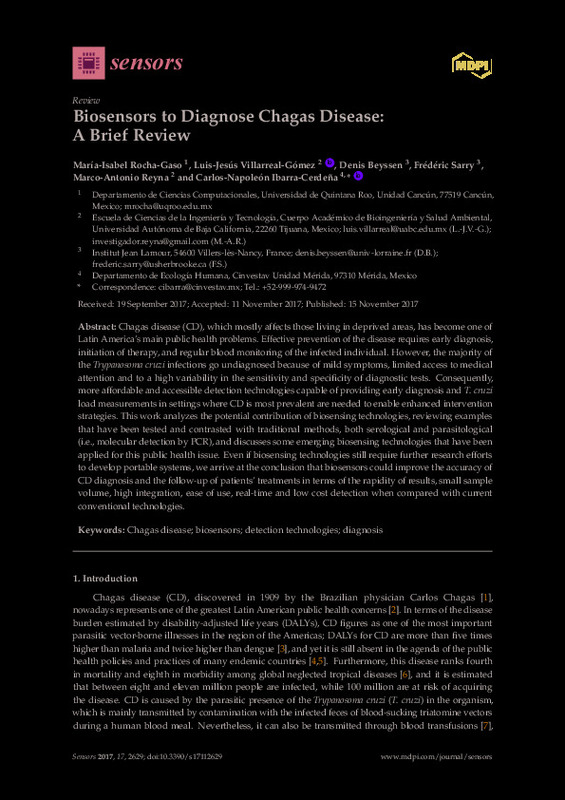JavaScript is disabled for your browser. Some features of this site may not work without it.
Buscar en RiuNet
Listar
Mi cuenta
Estadísticas
Ayuda RiuNet
Admin. UPV
Biosensors to Diagnose Chagas Disease: A Brief Review
Mostrar el registro sencillo del ítem
Ficheros en el ítem
| dc.contributor.author | ROCHA GASO, MARÍA ISABEL
|
es_ES |
| dc.contributor.author | Villarreal-Gómez, Luis-Jesús
|
es_ES |
| dc.contributor.author | Beyssen, Denis
|
es_ES |
| dc.contributor.author | Sarry, Frederic
|
es_ES |
| dc.contributor.author | Reyna, Marco-Antonio
|
es_ES |
| dc.contributor.author | Ibarra-Cerdeña, Carlos-Napoleón
|
es_ES |
| dc.date.accessioned | 2023-02-28T19:00:47Z | |
| dc.date.available | 2023-02-28T19:00:47Z | |
| dc.date.issued | 2017-11-15 | es_ES |
| dc.identifier.uri | http://hdl.handle.net/10251/192159 | |
| dc.description.abstract | [EN] Chagas disease (CD), which mostly affects those living in deprived areas, has become one of Latin America's main public health problems. Effective prevention of the disease requires early diagnosis, initiation of therapy, and regular blood monitoring of the infected individual. However, the majority of the Trypanosoma cruzi infections go undiagnosed because of mild symptoms, limited access to medical attention and to a high variability in the sensitivity and specificity of diagnostic tests. Consequently, more affordable and accessible detection technologies capable of providing early diagnosis and T. cruzi load measurements in settings where CD is most prevalent are needed to enable enhanced intervention strategies. This work analyzes the potential contribution of biosensing technologies, reviewing examples that have been tested and contrasted with traditional methods, both serological and parasitological (i.e., molecular detection by PCR), and discusses some emerging biosensing technologies that have been applied for this public health issue. Even if biosensing technologies still require further research efforts to develop portable systems, we arrive at the conclusion that biosensors could improve the accuracy of CD diagnosis and the follow-up of patients' treatments in terms of the rapidity of results, small sample volume, high integration, ease of use, real-time and low cost detection when compared with current conventional technologies. | es_ES |
| dc.description.sponsorship | M.I.R.-G., F.S. and D.B. thank the Agence National de la Recherche (ANR), for its financial support by granting the international AWESOM project. The authors of this work are also grateful to Janine W. Ramsey for her useful comments and suggestions about Figure 2 | es_ES |
| dc.language | Inglés | es_ES |
| dc.publisher | MDPI AG | es_ES |
| dc.relation.ispartof | Sensors | es_ES |
| dc.rights | Reconocimiento (by) | es_ES |
| dc.subject | Chagas disease | es_ES |
| dc.subject | Biosensors | es_ES |
| dc.subject | Detection technologies | es_ES |
| dc.subject | Diagnosis | es_ES |
| dc.subject.classification | TECNOLOGIA ELECTRONICA | es_ES |
| dc.title | Biosensors to Diagnose Chagas Disease: A Brief Review | es_ES |
| dc.type | Artículo | es_ES |
| dc.identifier.doi | 10.3390/s17112629 | es_ES |
| dc.rights.accessRights | Abierto | es_ES |
| dc.contributor.affiliation | Universitat Politècnica de València. Escuela Técnica Superior de Ingeniería del Diseño - Escola Tècnica Superior d'Enginyeria del Disseny | es_ES |
| dc.description.bibliographicCitation | Rocha Gaso, MI.; Villarreal-Gómez, L.; Beyssen, D.; Sarry, F.; Reyna, M.; Ibarra-Cerdeña, C. (2017). Biosensors to Diagnose Chagas Disease: A Brief Review. Sensors. 17(11):1-12. https://doi.org/10.3390/s17112629 | es_ES |
| dc.description.accrualMethod | S | es_ES |
| dc.relation.publisherversion | https://doi.org/10.3390/s17112629 | es_ES |
| dc.description.upvformatpinicio | 1 | es_ES |
| dc.description.upvformatpfin | 12 | es_ES |
| dc.type.version | info:eu-repo/semantics/publishedVersion | es_ES |
| dc.description.volume | 17 | es_ES |
| dc.description.issue | 11 | es_ES |
| dc.identifier.eissn | 1424-8220 | es_ES |
| dc.identifier.pmid | 29140309 | es_ES |
| dc.identifier.pmcid | PMC5712880 | es_ES |
| dc.relation.pasarela | S\482509 | es_ES |
| dc.contributor.funder | Agence Nationale de la Recherche, Francia | es_ES |








